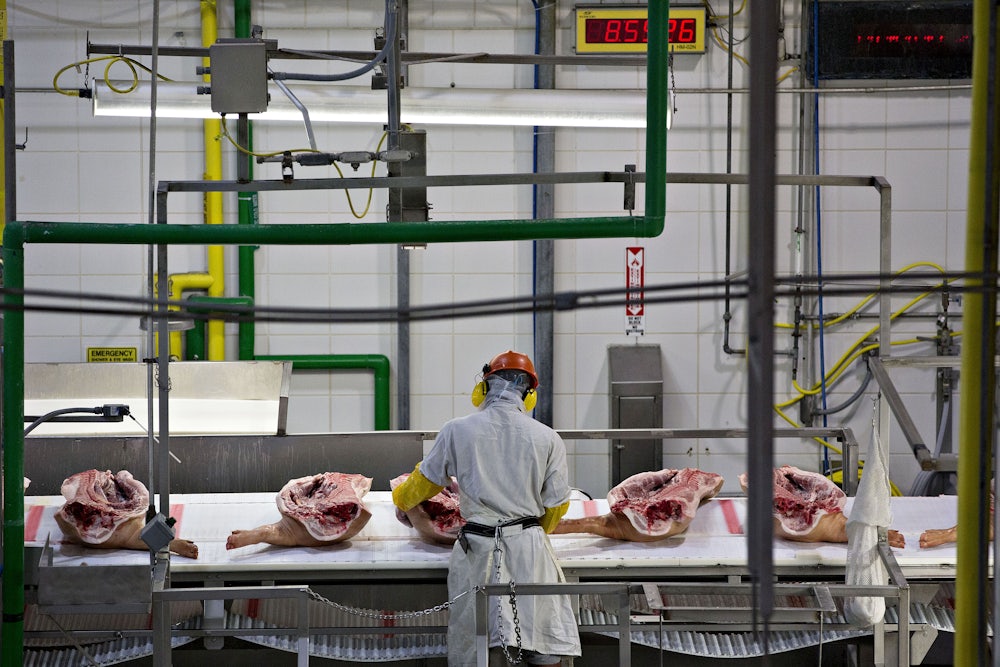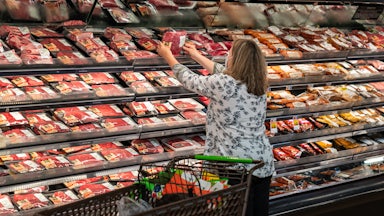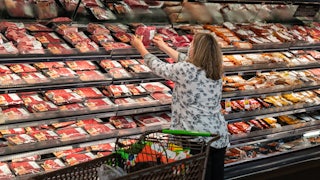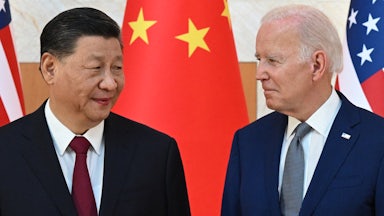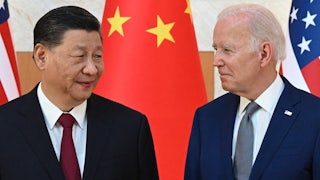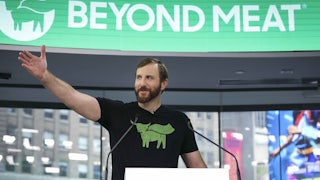Every few months in recent years, Western news readers have been treated to a macabre tale: companies in China building massive multistory pig factory farms to feed the country’s appetite for pork. The agro-industrial phantasmagoria grows in scale with every iteration. Last week, The New York Times reported the construction of a 26-floor megafarm in Hubei province, which, once joined by a twin facility, will be able to raise and slaughter over a million pigs each year—“a Foxconn factory for pigs,” the Times called it, “with the precision required of an iPhone production line.”
Yet the carceral brutalism displayed in the Times’ exclusive photos and footage of the new pork high-rise distracts from an uncomfortable truth: This Chinese factory-farming dystopia merely reflects our own. It is a distinction of form, not type, with far more similarities than differences. If the point of these reports is to alert readers to the environmental, political, and ethical disaster wrought by factory farming, then we should focus just as much on factory farming’s birthplace, the United States.
Pork has long been a favorite meat in China but did not become a daily staple until the country’s push for agricultural modernization starting in the 1970s and accelerating in the new millennium, accompanied by the rise of an increasingly affluent urban consumer class. Today, China is the world’s biggest producer, importer, and consumer of pork, both total and per capita, with the average Chinese consumer eating close to 70 pounds each every year to Americans’ 50. But pork is more than just a staple in China; it is a metonym for Chinese agricultural modernization and food policy over the past few decades.
To ensure a plentiful supply of pork for a growing population and in the face of relatively scant arable land, the Chinese public and private sector have worked cheek by jowl for decades to replace the country’s traditional and small-scale pork production with the American-style concentrated animal feeding operation—CAFO, or factory farm—model. This meant embracing what the environmental studies researcher Mindi Schneider terms an “industrial meat regime” as a mode of organizing Chinese agro-industrial development, meaning ever-larger farms relying on a standardized labor force and standardized, mass-produced imports like soy. To feed an exponentially expanding number of pigs, China converted agricultural land to monocrop soy production, and the country also quickly became one of the world’s biggest importers of soy.
Keeping pork available and cheap is so central to Chinese government policy that the country maintains a strategic pork reserve to bolster the market in case of shortages caused by disruptions like Covid-19. The Chinese government has also sought to help its domestic pork industry modernize by underwriting ostensibly private investment in best-in-business companies like the American pork giant Smithfield, which was taken over by a Chinese holding company in 2013 for $4.7 billion, in what was then the largest takeover of an American company by a Chinese one in history.
This push for ubiquitous pork has come with a price, including the disruption of smallholder farming, widespread environmental degradation, and ever more frequent outbreaks of disease. Porcine epidemic diarrhea virus, or PEDv—which spread to the United States in 2013, causing millions of pig deaths—as well as scores of variants on influenza, are endemic, regularly killing millions of animals and, in isolated cases, jumping to humans. And in 2019, China suffered a pig industry disaster when African swine fever tore through its farms, killing anywhere between 20 percent and 40 percent of the country’s pigs.
Hog towers like the one in Hubei are an attempt to resolve these intersecting problems of land and water constraints, the need to maintain a secure domestic pork supply and minimize reliance on fragile international value chains, and the desire to limit the spread of disease. They’re designed to be true factories for meat: pigs across different stages of their lives from birth through death housed in separate units, fed specialized diets through automated feeders, and monitored 24 hours a day, their manure tracked and repurposed into electricity-generating methane.
In a way, it’s a marvel of a particular type of ecomodernism: minimizing the impact while maximizing the gain of industrial animal agriculture by maximizing the industrialization and minimizing the agriculture. This may help explain why the farm’s owners welcome the foreign press and boast of their technological and architectural innovations.
But if you can look past the shock value in the Times’ coverage, it’s clear that what the Chinese are doing is emulating and, in a sense, improving on a quintessentially American way of producing meat. Indeed, the U.S. was once just as proud of its own multistory, industrialized, suburban animal slaughter facilities.
When Chicago hosted the World’s Columbian Exhibition in 1893, visitors flocked by the thousands to see the novel industrial slaughterhouses on the city’s South Side, where the meat barons had devised the bloody “disassembly lines” where low-skilled laborers could kill and chop up hundreds of animals every day to create standardized cuts of meat for a growing urban customer base. (Upton Sinclair’s The Jungle would eventually expose the distasteful reality behind these guided and sanitized tours.)
The very notion of industrialized animal slaughter and farming is a thoroughly American construct. Just as has happened in China over the past few decades, in the U.S. the government has been responsible for pushing large-scale, industrial agriculture and facilitating business for big farmers. It was the U.S. that pioneered not just industrial slaughter but also industrial farming, devising ways to maximize the profitability and efficiency of meat production, and allowing Americans to gorge on over 220 pounds of cheap meat each, every year. Modern factory farms in the U.S. are every bit as technologically advanced, if not more so, than Chinese ones, with animals’ genetics rewritten, diets recalibrated, and lives entirely synced to the beat of the market. The difference is that American meat factories, unlike Chinese ones, spread their activities among numerous single-story buildings. And they no longer welcome journalists and photographers—in fact, they prosecute those who expose their practices.
Today, about 98 percent of all animals raised for food in the U.S. come from factory farms. Entire states like Iowa have had their economies and geographies entirely reshaped to serve Big Pork, crushing small farms in the process. This trend, as the anthropologist Alex Blanchette detailed in his 2020 book, Porkopolis, has reshaped rural America, creating de facto factory towns built around industrial farming.
This comes with extensive externalities. Mass-scale hog production contributes to climate change through greenhouse gas emissions, including from the massive manure lagoons that store animals’ excrement. These pools also have a tendency to overflow, poisoning groundwater and killing off fish. Nor has the U.S. avoided animal disease, with outbreaks of PEDv and swine flu decimating pig populations. Meanwhile, the new meat barons run roughshod over American regulations and democracy, pushing for ag-gag laws that stifle whistleblowing, challenging public demands for improved animal welfare in court, stymying local democratic control over zoning, pushing for biogas projects to develop income streams for their methane-generating manure lagoons, strong-arming the government into keeping slaughterhouses open during Covid-19, and then denying workers and their families benefits and relying on legal exemptions to everything from child labor to bestiality laws to maximize their profits. The U.S. is, as a Food and Water Watch report bluntly puts it, a “factory farm nation.”
Much like the periodic Western critiques of China’s Yulin dog meat festival, outrage over the high-rise pig farms blends legitimate criticism with orientalist deflection. Any American reporting on China’s meat industry at this point ought to come with a caveat: While the rise of factory farming in China is indeed nightmarish, this should be an indictment not of China but of the noxious industrial-political model of animal production pioneered by the U.S. and now spreading globally. It is the what, not the where, that’s the problem. China’s factory farms should be seen by Western readers for what they are: a mirror to the horror of factory farming at home.
